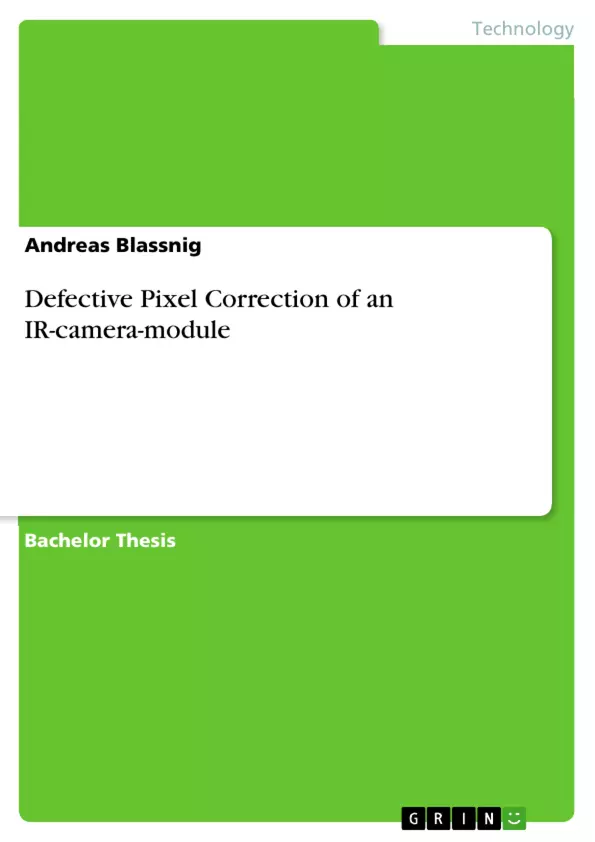This paper deals with the substitution of defective sensor pixels regarding an Infrared Energy (IR) camera module. The work includes information about the development of algorithms and the optimization regarding hardware usage of a Field Programmable Gate Array (FPGA). Furthermore, the work outlines the test of the algorithms with the aid of Matrix Laboratory (Matlab) and the implementation in Very high speed integrated circuit Hardware Description Language (VHDL). Simulations of the VHDL module conclude the work.
Inhaltsverzeichnis
- Vorwort
- Aufgabe
- Realisierung
- Definition von defekten Pixeln
- Typen von Defekten bezüglich monolithischer pyroelektrischer Arrays
- Typen von Defekten bezüglich Mikrobolometertechnologie
- Substitutionsalgorithmen
- Einzelpixelsubstitution
- Clusterfehlerkorrektur
- Zeilen- und Spaltenfehler
- Tests mit Matlab
- Import von Testbildern
- Korrektur und Darstellung von Testbildern
- VHDL-Programmierung
- Entitätsdeklaration und Datentransfer
- Speicherverwaltung
- Implementierung von Algorithmen
- Simulation und Tests
- Definition von defekten Pixeln
- Schlussfolgerung
- Erkenntnisse
- Ausblick
- Abbildungsverzeichnis
- Tabellenverzeichnis
- Abkürzungsverzeichnis
- Literaturverzeichnis
- Anhang
Zielsetzung und Themenschwerpunkte
Die vorliegende Bachelorarbeit befasst sich mit der Korrektur defekter Sensorpixel in einem Infrarot-Kamerasystem. Ziel ist die Entwicklung und Implementierung von Algorithmen, die die negativen Auswirkungen defekter Pixel auf die Bildqualität minimieren. Die Arbeit umfasst die Entwicklung von Algorithmen, deren Optimierung hinsichtlich des Hardware-Aufwands in einem FPGA, sowie die Simulation und Tests der Algorithmen mithilfe von Matlab. Die Arbeit gipfelt in der VHDL-Implementierung des Algorithmus und der Simulation des VHDL-Moduls.
- Defekte Pixel in Infrarot-Kamerasystemen
- Entwicklung von Algorithmen zur Korrektur defekter Pixel
- Optimierung der Algorithmen hinsichtlich des Hardware-Aufwands
- Simulation und Tests der Algorithmen in Matlab
- VHDL-Implementierung und Simulation des Korrekturmoduls
Zusammenfassung der Kapitel
Das erste Kapitel führt in die Thematik der defekten Pixel in Infrarot-Kamerasystemen ein und erläutert die Notwendigkeit von Korrekturalgorithmen. Das zweite Kapitel befasst sich mit der Realisierung der Korrektur. Zunächst werden verschiedene Arten von Defekten bei pyroelektrischen Arrays und Mikrobolometertechnologien definiert. Anschließend werden verschiedene Substitutionsalgorithmen vorgestellt, die zur Korrektur von Einzelpixelfehlern, Clusterfehlern und Zeilen- und Spaltenfehlern eingesetzt werden können. Die Algorithmen werden in Matlab simuliert und getestet, um deren Effizienz und Genauigkeit zu beurteilen. Das dritte Kapitel fasst die Ergebnisse der Arbeit zusammen und gibt einen Ausblick auf mögliche zukünftige Forschungsarbeiten.
Schlüsselwörter
Die Schlüsselwörter und Schwerpunktthemen des Textes umfassen defekte Pixel, Infrarot-Kamerasysteme, FPGA, VHDL, Algorithmen, Bildverarbeitung, Matlab, Simulation, Tests, Hardware-Optimierung und Korrektur.
- Quote paper
- Andreas Blassnig (Author), 2009, Defective Pixel Correction of an IR-camera-module, Munich, GRIN Verlag, https://www.grin.com/document/133913



